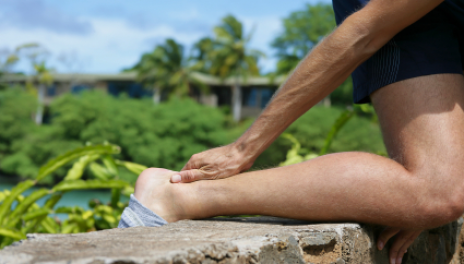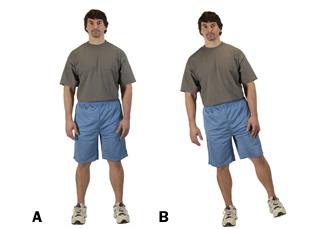 The Achilles tendon is among the longest tendons in the body that stretches from the calf muscles to the bones present in the heel. It is a springy band of tissue located above the heel and at the back of the ankle which can be felt when you move. Achilles tendon lets you aim your toes at the floor and stretch your foot.
The Achilles tendon is among the longest tendons in the body that stretches from the calf muscles to the bones present in the heel. It is a springy band of tissue located above the heel and at the back of the ankle which can be felt when you move. Achilles tendon lets you aim your toes at the floor and stretch your foot.
Sadly, the Achilles tendon tends to get injured very easily. Tendinitis is the leading cause for Achilles tendon pain and injuries which results in swelling of the tendon and extreme pain. Putting force on the tendon can result in a small tear or a complete rupture in severe cases of Achilles tendon injuries.
What Causes Pain in Achilles Tendon?
1. Injury
Achilles tendon injuries can be caused by:
- Exaggerated use
- Increasing physical activity regime abruptly
- Using high heels that put a lot of pressure on the tendon
- Fat feet can cause an injury to the Achilles tendon which is also known as overpronation or fallen arches. People suffering from this condition are susceptible to stretching their tendons and muscles because the impact of a step can cause the arch of their foot to collapse.
- Tightness in the leg muscles or tendons
2. Inflammation
Achillestendinopathy is the name of a condition in which a person suffers weakness, pain, stiffness and swelling in the Achilles tendon which connects the calf muscles to the heel bone. Repetitive minor injuries to the Achilles tendon are believed to be the cause of this condition. Achilles tendonosis and Achilles tendinitis are two common conditions.
Achilles tendinitis is basically a condition in which the Achilles tendon becomes inflamed. This soreness does not last long though. However, if it is not treated, it can develop into a degenerative condition known as Achilles tendonosis. In this condition, microscopic tears occur in the tendon and it loses its organized anatomy. The degeneration, in some cases, targets the area where the Achilles tendon and the heel bone meet. Rupturing of the tendon can occur in rare cases of chronic degeneration that might accompany pain.
Achilles tendonosis and tendinitis can have the following symptoms:
- A soreness, tenderness, stiffness or aching pain anywhere in the tendon. This pain usually appears early in the morning or after you have taken rest and lessens with movements, but increases if you remain active for long.
- Intense pain and tenderness upon squeezing of the side of the tendon. The backside of the tendon does not feel that tender when you press directly over it.
- If degeneration occurs then enlargement of the tendon might occur and there is also chance of nodule formation where the tissue damage took place.
When to Contact a Medical Professional
You must contact your doctor immediately and seek treatment if you are having Achilles tendon pain which aggravates when you move.
How to Relieve the Pain
Surgery is not among the usual treatment options for Achilles tendinitis. It might take up to 3 months for the pain to easy off even after receiving treatment.
1. Rest
Patients of Achillestendinopathy need to rest and stop participating in sporting activities for a while. High impact activities like running should be immediately stopped. Exercise can be started as the pain goes down but only if you are able to do it without experiencing pain. Complete rest is actually not that good for the injury. You should consult your doctor regarding the resumption of your exercise regime.
2. Painkillers
Ibuprofen and Naproxen are NSAIDs (Non-Steroidal Anti-Inflammatory Drugs) that can reduce the Achilles tendon pain and subside the swelling. However, prolong use of these drugs can cause side effects therefore they should only be used sparingly and with the consultation of your doctor.
3. Changes in Movements
Making slight modifications in the movements can also prove to be helpful in managing the symptoms. For instance, walking on smooth surfaces, refraining from doing activities that cause pain and switching to biking and swimming which does not put much pressure on the Achilles tendon can all help.
4. Adjustment in Footwear
Footwear changes are also suggested for people suffering from pain in the Achilles tendon. Using a boot, brace or a cast to hold the heel still can help in subsiding swelling while heel lifts and shoes that cushion the heel can reduce the pain during movements.
5. Other Treatments
- Other treatments include icing the tendon for a period of 15 to 20 minutes for at least 3 times each day.
- Surgery is only used to remove bone spurs that are irritating the tendon or removing the inflamed tissue on the tendon. ESWT or Extracorporeal shock wave therapy, which uses low-dose sound waves, is an alternative treatment for people who are not responding to other treatments and want to avoid surgery.
Exercises to Relieve Achilles Tendon Pain
1. Weight Shift

Stand on tip-toe with the weight on your unaffected leg. Now slowly transfer the weight on the affected leg while lowering down. Repeat this exercise 15 times per set and do at least 3 sets twice a day. You can perform this exercise either with straight or bent knees.
2. Make Use of Steps
Facing upstairs, place your legs on the bottom step of stairs so that your heels are slightly off the step end. Now holding the railing for support, lower the heels while keeping the knees straight. Remain in this position for up to 60 seconds and then relax. Repeat this exercise 6 times and do it two times in a day.
3. Towel Puling

When you wake up in the morning, loop a towel around your foot and pull it towards you while keeping your knee straight. Keep puling for at least 30 seconds and repeat it thrice on each foot. The aim of the exercise is to pull the upper part of your foot and your toes towards your body.
4. Planted Heel
Sit on the chair with your feet firmly planted on the floor. Now, lift your foot upwards while keeping the heel planted. Remain in this position for a few seconds and then relax. Repeat this exercise 10 times and try to do it for at least 6 times a day.
